Two danish 1 Krone coins strung on conductive thread. When the coins meet the electrical contact between the threads is bridged, thus closing the “switch”. There are so many different kinds of materials in the world! Conductive, resistive, pizeoresistive, semi-conductive, non-conductive. We use them every day, in all kinds of different ways. Why not use them to build and customize our very own sensors.
Instructable >> http://www.instructables.com/id/EVXAD27HW6T1Z6S/
The Danish Krown Slide-Switch is one example of a sensor assembled from materials you’d encounter in your every day life. Two Danish Kroner coins, some conducive thread and a piece of felt. It detects whether two Danish Krowns are touching or not. If they are touching, the switch is closed. If they are not touching the switch is open. Connected to further circuitry, this simple homemade switch can be used to turn on and off a light. Switch the TV channel. Turn up the volume on your iPod. Click a button on your keyboard. Add effects to your synthesizer. And so much more.
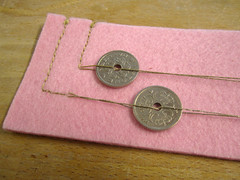
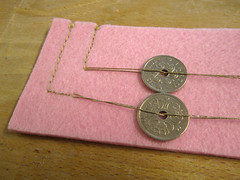
How-To:
Materials and Tools
MATERIALS:
– 2 x Danish Krowns (or other currency with hole in center of coin)
– 1m of conductive thread
– 10 x 20 cm of thick (3-5mm) felt
TOOLS:
– Scissors
– Sewing needle
Sewing with Conductive Thread
Tie a knot in the end of your conductive thread. Start by sewing through the back of the felt at one end of the coin’s slider paths. Make sure the knot holds at the back of the felt, or sew back and forth to have a stable starting point.
Thread the thread through the hole of one coin, then continue sewing to the felt about 15cm away from your starting point (knot). Sew to the edge of the felt and create a tab there that will be one of the leads (connection points) of your sensor.
Now back-track and sew back through the hole in the coin, but this time sew through the hole the opposite way you sewed through it the first time!
Sew back into the fabric at your starting point and tie a knot in the thread to end the sewing.
Repeat the above instructions for the second coin and it’s slider path.
TIP: Use a bit of nail-varnish on the knots of conductive thread to keep them from coming undone.
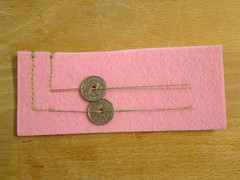
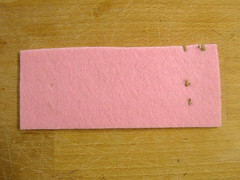
TESTING
To test your sensor works, you can simply hook it up to a multimeter. Connect either tab of your sensor to a lead from the multimeter. Set the multimeter to measure continuity (“–>|”, “beep”) or resistance (“Ω”, Ohm).
When the coins are not touching the multimeter should not beep, or show no resistance.
When the coins are touching the multimeter should beet, or show a relatively low (less than 100 Ohm) resistance.
You can also connect your sensor to a basic circuit consisting of a power source (battery) and LED light, similar to this Resistance Visualization Tool circuit >> http://www.kobakant.at/DIY/?p=5054
Trouble-shooting:
If your sensor is constantly connected: check the back of your sewing to make sure the conductive threads are not touching anywhere.
If your sensor never connects: use the multimeter to check that your coins, your thread and the connections all the way back to either lead of the multimeter are conductive.

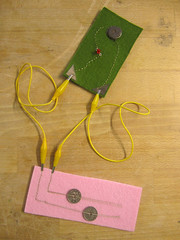








Leave a comment